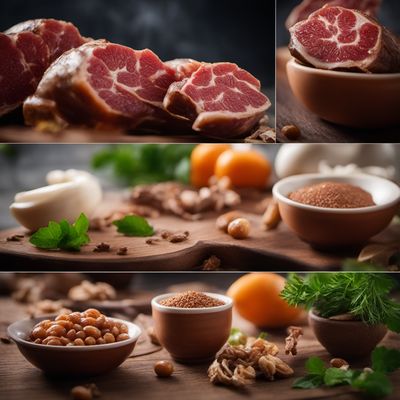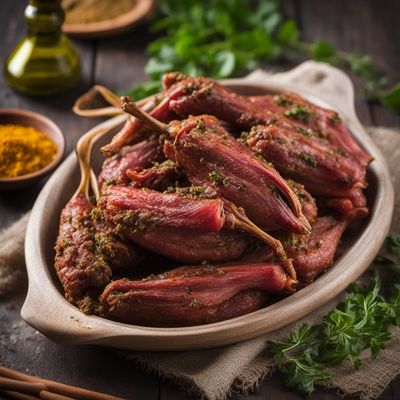
Ingredient
Deer carcase
Venison: The Wild Delicacy
Venison, derived from deer, is a lean and tender meat with a distinct flavor. It has a deep, earthy taste with subtle gamey undertones. The texture of venison can vary depending on the cut, ranging from tender and juicy to slightly chewy. Its appearance is typically dark red and lean, with minimal fat marbling.
Origins and history
Venison has a long history of consumption, dating back to ancient times. It has been a staple in many cultures, including Native American, European, and Asian cuisines. In medieval Europe, venison was considered a luxury food reserved for the nobility. Today, it is still highly regarded as a delicacy and is often associated with hunting traditions and rustic cooking.
Nutritional information
Venison is a nutrient-dense meat, rich in protein, iron, and B vitamins. It is also lower in fat and calories compared to other red meats, making it a healthier choice for meat lovers. A 3-ounce serving of venison provides approximately 150 calories, 26 grams of protein, and 2 grams of fat.
How to select
When selecting venison, look for cuts that are deep red in color, with little to no discoloration or browning. The meat should have a fresh, slightly sweet aroma. Avoid cuts that appear dry or have a strong odor. Opt for venison sourced from reputable suppliers or local hunters to ensure quality and sustainability.
Storage recommendations
To maintain the freshness of venison, store it in the refrigerator at a temperature below 40°F (4°C). Keep the meat well-wrapped in butcher paper or vacuum-sealed to prevent freezer burn. Use fresh venison within 2-3 days, or freeze it for longer storage, up to 6 months.
Preparation tips
Venison can be prepared in various ways, including grilling, roasting, braising, or stewing. Marinating the meat before cooking can help tenderize it and enhance the flavors. Venison pairs well with bold, earthy flavors such as juniper berries, rosemary, and red wine. It is commonly used in dishes like venison steaks, stews, sausages, and jerky.
Substitutions
Beef, bison, or elk can be used as substitutes for venison, although they may have slightly different flavors and textures. However, if venison is not available, it can be challenging to find an exact substitute due to its unique taste and characteristics.
Culinary uses
Venison is widely used in various cuisines around the world. It is commonly featured in dishes like venison roasts, steaks, burgers, sausages, and stews. In European cuisines, venison is often paired with rich sauces and served with seasonal vegetables. In North America, it is popularly used in hearty game dishes and chili.
Availability
Venison is commonly available in regions with a strong hunting culture, such as North America, Europe, and parts of Asia. It can be found in specialty butcher shops, farmers markets, and some supermarkets. Additionally, venison is often sourced directly from hunters or game farms.
More ingredients from this category » Browse all

Horse carcase
The Noble Beast: Horse Meat

Wild boar carcase
Untamed Bounty: Wild Boar

Ratites carcase
The Exotic Delicacy: Ratites Carcase Unveiled

Sheep carcase
The Art of Lamb: Exploring the Versatility of Sheep Carcass

Goat carcase
The Wholesome Base

Bovine carcase
The Foundation of Flavor

Asses-mules-hinnies carcase
The Forgotten Meat

Goose carcase
The Flavorful Foundation

Turkey carcase
The Versatile Turkey Carcase

Rabbit carcase
The Art of Rabbit: Unlocking the Culinary Potential of Rabbit Carcass

Duck carcase
The Essence of Duck: Unveiling the Secrets of Duck Carcase

Pig carcase
Pig Carcase: A Versatile Ingredient
